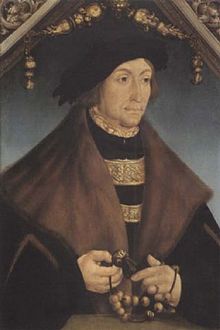George of the Palatinate

Georg von der Pfalz (born February 10, 1486 in Heidelberg , † September 27, 1529 in Kislau Castle near Bad Mingolsheim ) was Bishop of Speyer from 1513 to 1529.
Life
His parents were Elector Philipp and Margarete von Bayern-Landshut , a daughter of Ludwig the Rich .
He received canons in Mainz , Trier and Speyer , was provost of the cathedral in Mainz from 1499 to 1506 , and provost of St. Donatian in Bruges from November 10, 1502 , then pastor in Hochheim and Lorch. On February 12, 1513 he became Bishop of Speyer. After studying in Heidelberg in 1514, Georg was ordained a priest on July 10, 1515 and episcopal ordination on July 22 .
Pope Leo X commissioned him in 1514 to investigate a theological dispute between the Dominican inquisitor Jakob van Hoogstraten and Johannes Reuchlin . For the bishop, his learned cathedral dean Thomas Truchseß von Wetzhausen wrote a report in 1516, which declared Reuchlin's writings to be unsuspicious of any heresy and rehabilitated it. Originally the shepherd had entrusted his vicar general Georg von Schwalbach with this task, but he refused.
Georg tried to encourage the discipline of the clergy in his diocese and forbade the clergy to study Luther's writings. However, he could not prevent his auxiliary bishop Engelbrecht from joining the new teaching. He issued one of his most haunting letters to the clergy on April 28, 1523 and it says u. a .:
“ The suspicious teachings of Luther, which are quite contrary to the holy Catholic Church and the old traditions, are what we have to mention with great pain, in most places and parishes of our diocese by the pastors, preachers and by others who are neither from us nor from Our vicar general are set up to preach, scattered among the unlearned believers and planted, whereby not only error, rebellion, murder and dangerous movement of the congregations can arise among them ... We urge you to worship with elimination of all impropriety, with indulgence 'Seriousness, reverence, dignity, prudence, as much as possible with devotion, in the fear of the Lord, and to instruct the people not only in wholesome doctrine, but to teach them piety through good deeds, through an impeccable walk and through example encourage, so that when in this way all scandal is lifted and the contempt for the clergy is removed It is far away, as fighters of Christ and mediators between God and the people, we are able to appease and keep the penalty rod of the Eternal through our prayer and other good works. "

At Easter 1525, the Palatinate Peasants' War began in the diocese and the episcopal cellars were stormed. Georg fled to Heidelberg, the peasants took the castles of Kislau , Rothenberg and Bruchsal , set up a provisional government, flooded the Udenheim office and threatened Speyer himself. On April 29, 1525 Georg rode to the rebels in Herrenalb and promised them that they could accept preachers at will. In Udenheim (Philippsburg) he opened negotiations with them and signed a contract on May 5, 1525. The Palatinate and other princes finally put down the peasant uprising by force of arms . Afterwards the Speyer shepherd tried, according to the General German Biography , "to heal the wounds from these stormy days with mildness and justice and to promote the temporal well-being of his subjects" . In 1525 he appointed the cathedral capitular Johannes Brenner von Löwenstein († 1537) to be his vicar general .
Georg took part in the Reichstag in Speyer in 1529 and died on September 27 of the year of the epidemic known as English sweat . He was buried in Speyer Cathedral; his monument was destroyed by the French in 1689 during the War of the Palatinate Succession .
coat of arms
The prince-bishop's coat of arms is usually quartered . The fields of the coat of arms alternate with the family coat of arms of the Wittelsbach family and the coat of arms of the diocese of Speyer, a silver cross on a blue background.
literature
- Arthur Kleinschmidt : Georg of the Palatinate . In: Allgemeine Deutsche Biographie (ADB). Volume 8, Duncker & Humblot, Leipzig 1878, p. 698 f.
Individual evidence
- ↑ Hans Ammerich : The Speyer diocese and its history , Volume 3: From the Reformation to the end of the old diocese ; Kehl am Rhein 1999; ISBN 3-927095-49-4 ; P. 11.
Web links
| predecessor | Office | successor |
|---|---|---|
| Philip I of Rosenberg |
Prince-Bishop of Speyer 1513–1529 |
Philip II of Flersheim |
| personal data | |
|---|---|
| SURNAME | George of the Palatinate |
| BRIEF DESCRIPTION | German clergyman, Bishop of Speyer (1513–1529) |
| DATE OF BIRTH | February 10, 1486 |
| PLACE OF BIRTH | Heidelberg |
| DATE OF DEATH | September 27, 1529 |
| Place of death | Kislau Castle near Bad Mingolsheim |

